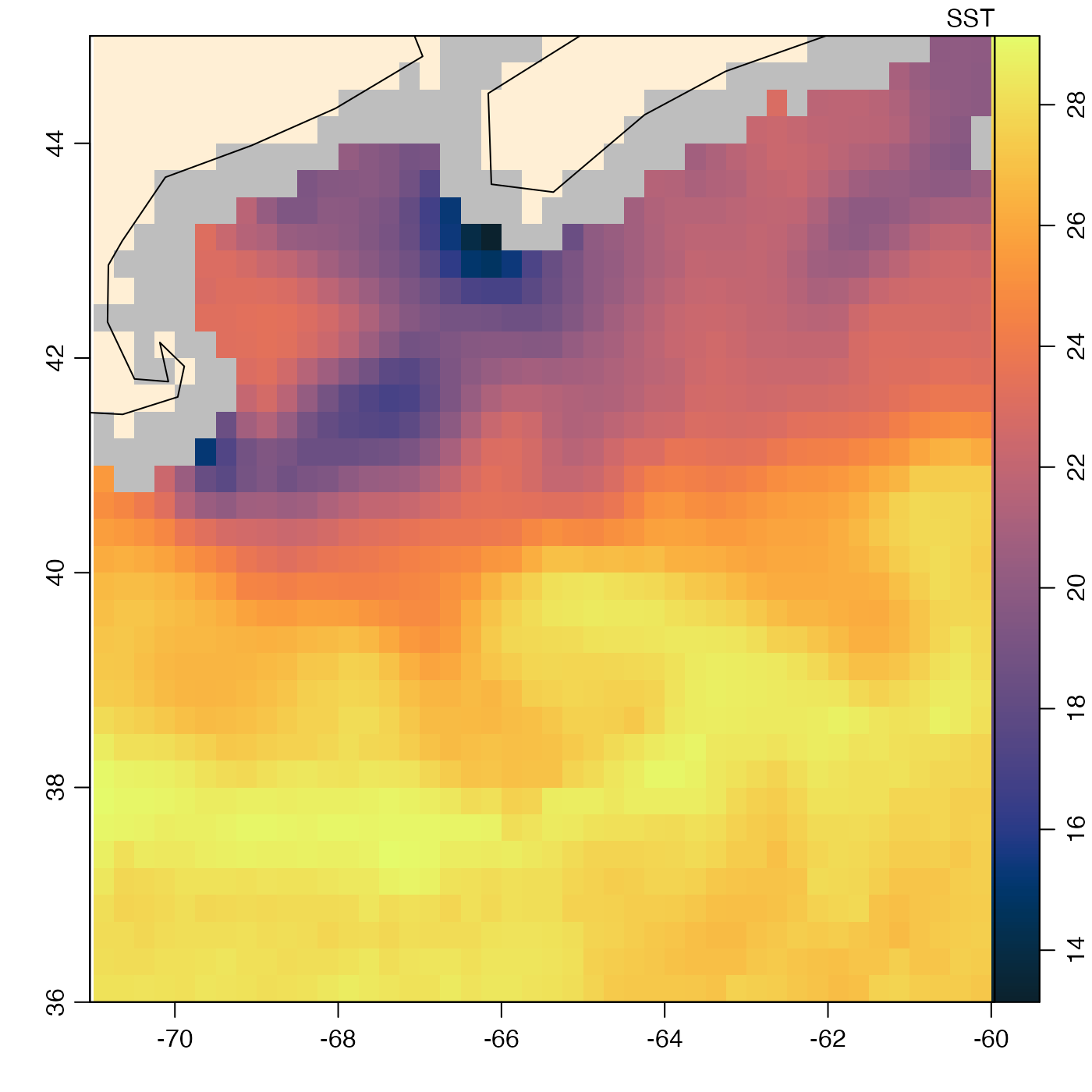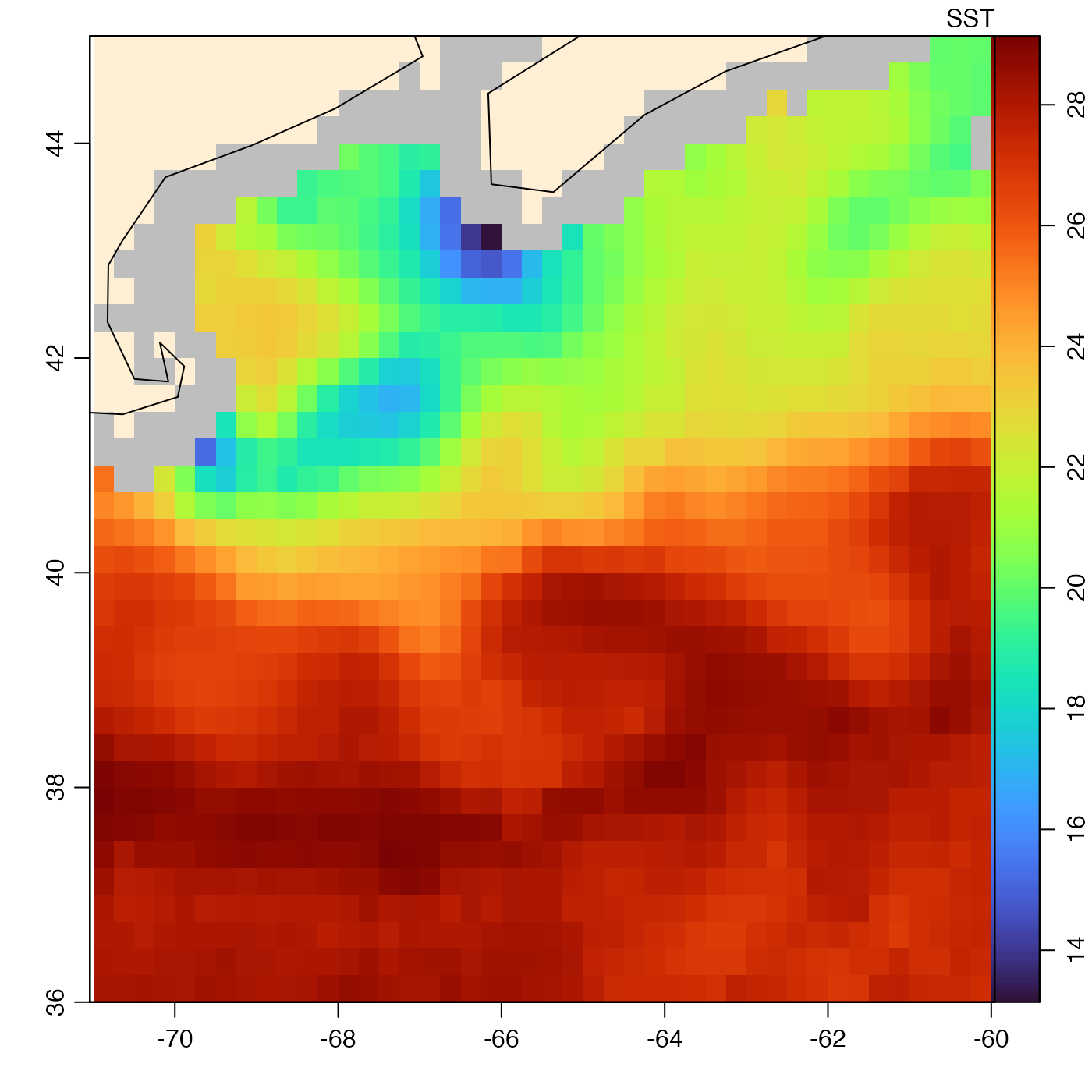Plot an image of a component of an amsr object.
Arguments
- x
an amsr object.
- y
character value indicating the name of the band to plot; if not provided,
SST(or a variant thereof) is used; see the documentation for the amsr class for a list of bands.- asp
optional numerical value giving the aspect ratio for plot. The default value,
NULL, means to use an aspect ratio of 1 for world views, and a value computed fromylim, if the latter is specified in the...argument.- breaks
optional numeric vector of the z values for breaks in the color scheme. If
colormapis provided, it takes precedence overbreaksandcol.- col
optional argument, either a vector of colors corresponding to the breaks, of length 1 less than the number of breaks, or a function specifying colors. If neither
colorcolormapis provided, thencoldefaults tooceColorsTemperature(). Ifcolormapis provided, it takes precedence overbreaksandcol.- colormap
a specification of the colormap to use, as created with
colormap(). Ifcolormapis NULL, which is the default, then a colormap is created to cover the range of data values, using oceColorsTemperature color scheme. Ifcolormapis provided, it takes precedence overbreaksandcol. See “Examples” for an example of using the "turbo" color scheme.- zlim
optional numeric vector of length 2, giving the limits of the plotted quantity. A reasonable default is computed, if this is not given.
- zlab
optional character value that is shown in the top-right margin of the plot. If not given, this defaults to the name of the plotted variable.
- pass
either NULL (the default), or character value that is either
"ascending"or"descending". The value ofpassis only examined for realtime data, which hold both ascending and descending passes in SST and related arrays.- missingColor
optional list specifying colors to use for non-data categories. If not provided, a default is used. For type 1, that default is
list(land="papayaWhip", none="lightGray", bad="gray", rain="plum", ice="mediumVioletRed"). For type 2, it islist(coast="gray", land="papayaWhip", noObs="lightGray", seaIce="mediumVioletRed"). Any colors may be used in place of these, but the names must match, and all names must be present.- debug
an integer specifying whether debugging information is to be printed during the processing. This is a general parameter that is used by many
ocefunctions. Generally, settingdebug=0turns off the printing, while higher values suggest that more information be printed. If one function calls another, it usually reduces the value ofdebugfirst, so that a user can often obtain deeper debugging by specifying higherdebugvalues.- ...
extra arguments passed to
imagep(), e.g. to control the view withxlim(for longitude) andylim(for latitude).
Details
In addition to fields named directly in the object, such as SSTDay and
SSTNight, it is also possible to plot computed fields, such as SST,
which combines the day and night fields.
See also
Other things related to amsr data:
[[,amsr-method,
[[<-,amsr-method,
amsr,
amsr-class,
composite,amsr-method,
download.amsr(),
read.amsr(),
subset,amsr-method,
summary,amsr-method
Other functions that plot oce data:
download.amsr(),
plot,adp-method,
plot,adv-method,
plot,argo-method,
plot,bremen-method,
plot,cm-method,
plot,coastline-method,
plot,ctd-method,
plot,gps-method,
plot,ladp-method,
plot,landsat-method,
plot,lisst-method,
plot,lobo-method,
plot,met-method,
plot,odf-method,
plot,rsk-method,
plot,satellite-method,
plot,sealevel-method,
plot,section-method,
plot,tidem-method,
plot,topo-method,
plot,windrose-method,
plot,xbt-method,
plotProfile(),
plotScan(),
plotTS(),
tidem-class
Examples
library(oce)
data(coastlineWorld)
data(amsr) # see ?amsr for how to read and composite such objects
# Example 1: plot with default color scheme, oceColorsTemperature()
plot(amsr, "SST")
lines(coastlineWorld[["longitude"]], coastlineWorld[["latitude"]])
 # Example 2: 'turbo' color scheme
plot(amsr, "SST", col = oceColorsTurbo)
lines(coastlineWorld[["longitude"]], coastlineWorld[["latitude"]])
# Example 2: 'turbo' color scheme
plot(amsr, "SST", col = oceColorsTurbo)
lines(coastlineWorld[["longitude"]], coastlineWorld[["latitude"]])
